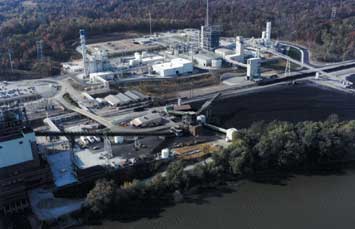Texas court grants injunction – no fast-tracking of coal
February 21st, 2007
YES!!! They won the injunction, and the standard for that is that they’re likely to succeed on the merits!
Here’s the NPR piece: Stopping the Texas Coal Rush
Here’s the letter issued by the Judge yesterday:
Judge Yelenosky’s Letter Ruling
It shaping up to be a great time for those of us opposing coal plants…
Judge blocks Perry’s fast-track order before Wednesday’s hearing
02/21/2007
By KELLEY SHANNON / Associated Press
Gov. Rick Perry’s executive order fast-tracking the permitting process for coal-fired plants is not binding on state hearing administrators, who must reconsider environmentalists’ requests for a hearing delay, a judge says.
Judge Stephen Yelenosky listened to arguments in state district court Tuesday then agreed with citizen environmental groups who claimed Perry didn’t have the constitutional authority to issue his fast-track order in October 2005.
A major permitting hearing for six coal plants was set for Wednesday in Austin.
Yelenosky’s temporary injunction did not cancel the hearing, but he said administrative judges should reconsider the schedule.
“What he’s saying (to administrative hearing judges) is the executive order does not tie your hands. It is without merit. You are now free to make your own decisions,” said plaintiffs’ attorney Jim Blackburn.
Lawyers for citizen groups argued before Yelenosky that Texas and Oklahoma residents opposed to the coal plants were at a disadvantage because there hadn’t been enough time to prepare for the high-stakes permit hearing.
The Texas Attorney General’s Office, which represented Perry in the case, referred all comments on the judge’s ruling to the governor’s office.
“No one should be surprised that a single liberal Austin judge would rule against Gov. Perry and his efforts to increase energy capacity in Texas,” spokesman Robert Black said. “We will take a close look at the ruling and make a determination on how we will proceed.”
At issue is Dallas-based TXU Corp.’s proposal to build six coal-fired plants in North, East and Central Texas.
“We’re obviously disappointed in this decision,” TXU spokeswoman Kim Morgan said. “Every day of delay means that meeting the goal of providing newer, cleaner power generation is denied.”
TXU contends the coal plants will lower utility costs and help provide needed power supplies for the future. The hearing should be held and the plants should be built, Morgan said, or the state will move closer “to the potential of widespread rolling blackouts.”
Unless action is taken now the electricity supplies in Texas will fall below reliable levels by 2009, she said.
Plaintiffs’ attorneys said the Texas governorship is intentionally weak under the Texas Constitution and that Perry’s executive order interferes with the legislative branch.
“The governor is doing something that he has no power to do,” said attorney David Kahne, representing Citizens Organizing for Resources and Environment, known as CORE, along with other plaintiffs.
The Legislature set up the State Office of Administrative Hearings as an independent forum for contested cases, and the governor doesn’t have the authority to direct the way it holds its hearings, Kahne told the judge Tuesday.
State attorneys said the plaintiffs failed to show how they would be irreparably harmed by the upcoming environmental hearings.
“There is no injury based on this purported accelerated schedule” of hearings, said Shelley Dahlberg, an attorney for the state. She said the citizen groups don’t have legal standing to make the argument that they’ve been harmed at this point, though they might after the hearings, depending on the outcome.
But Yelenosky disagreed and found that the plaintiffs did have standing.
A number of Texas cities and citizen groups oppose the plants.
“We’re actually in the ring of fire,” said Robert Cervenka, a rancher in McLennan County who lives amid proposed coal plant sites. Outside the courtroom Tuesday, he said he and his wife worry that the proposed plants would hurt the air quality for animals and people.
Katrina Baecht, whose family farm is six miles from the site of a proposed plant in Fannin County near the Oklahoma border, said she also worries about air pollution if the coal plants are built.
“I’m concerned about what it’s going to do to the health of the area where I was born and raised,” she said, “and I want to leave a better legacy behind.”
IGCC in NYT, & Excelsior ALJ recommendation due
February 21st, 2007

Today, the ALJs’ recommendation to the Commission is due in the Excelsior Mesaba Project docket, the one where Excelsior is trying to force a PPA on Xcel. While we’re all waiting huddled around our computers, here’s some evidence of the shifting tide, the awakening of cerebellums ruminating about IGCC:
 February 21, 2007
Cleaner Coal Is Attracting Some Doubts
By MATTHEW L. WALD
WASHINGTON, Feb. 20 — Within the next few years, power companies are planning to build about 150 coal plants to meet growing electricity demands. Despite expectations that global warming rules are coming, almost none of the plants will be built to capture the thousands of tons of carbon dioxide that burning coal spews into the atmosphere.
Environmentalists are worried, but they put their faith in a technology that gasifies the coal before burning. Such plants are designed, they say, to be more adaptable to separating the carbon and storing it underground.
Most utility officials counter that the gasification approach is more expensive and less reliable, but they say there is no need to worry because their tried-and-true method, known as pulverized coal, can also be equipped later with hardware to capture the global warming gas.
But now, influential technical experts are casting doubts on both approaches.
“The phrases ‘capture ready’ and ‘capture capable’ are somewhat controversial,†said Revis James, the director of the energy technology assessment center at the Electric Power Research Institute. “It’s not like you just leave a footprint for some new equipment.â€
Many experts outside the industry share his concerns.
A major new study by faculty members at the Massachusetts Institute of Technology, scheduled for release soon, concludes in a draft version that it is not clear which technology — the so-called integrated gasification combined cycle or pulverized coal — will allow for the easiest carbon capture, because so much engineering work remains to be done.
“Other than recommending that new coal combustion units should be built with the highest efficiency that is economically justifiable, we do not believe that a clear preference for one technology or the other can be justified,†the draft concludes. The M.I.T. study said it was critical that the government “not fall into the trap of picking a technology ‘winner.’ â€
The study leader, Ernest J. Moniz, a former assistant secretary of energy in the Clinton administration, was more blunt. “Clearly in a lot of discussions, I.G.C.C. has been anointed as the solution,†he said referring to integrated gasification combined cycle. He made his comments at a symposium organized by the Aspen Institute in Washington last fall. “We certainly don’t agree with that.â€
Retrofitting either a gasification or pulverized coal power plant is not just a matter of adding new equipment and it might be impractical, the experts say. Temperatures and pressures would be designed to be in one range for a plant that captured its carbon, and another if it merely produced electricity with minimum use of fuel. Less fuel means less carbon dioxide production.
Adding carbon capture later also has implications for power supply. Early estimates are that carbon capture will require so much energy that it could reduce plant output by 10 to 30 percent.
Some experts say that the best choice may vary according to the type of coal used. Coal with high moisture content may be less suitable for gasification.
The technical assessment is certainly at odds with the hopes expressed by environmentalists. The TXU Corporation of Dallas is planning a fleet of huge new coal plants of the pulverized variety. In Austin, Tex., Tom Smith, a researcher at Public Citizen, who is helping lead the opposition, said, “It’s clear that coal gasification is by far preferable to building traditional pulverized coal plants.†On Tuesday a Texas District court judge blocked a plan by the governor to “fast track†TXU’s application.
Getting carbon out of the gas stream before combustion must be easier, Mr. Smith said, because the post-combustion gases in a pulverized coal plant are 160 times as great.
Some utility executives agree. David Crane, the chief executive of NRG Energy, said that at some point engineers might work out an economical way to capture carbon after combustion in a pulverized coal plant, but that does not exist now.
Because carbon regulation is coming, he said, gasification plants will be needed.
“For the next generation, it’s clear to me that rather than build a bunch of pulverized coal plants, with their 50-year life, the country is much better off if we go to I.G.C.C.,†he said. The company is planning such a plant in Tonawanda, N.Y.
Others point out that carbon capture from gas made from coal has proved workable, at least at a relatively small nonpower plant that manufactures methane, but that it is still unproved at a large power plant. They say the only way to prove its feasibility is to go ahead now, rather than simply build plants to be modified later.
“There is no reason to wait,†Robert H. Socolow, a professor at Princeton who is an expert on carbon capture, said in an e-mail message. “We are going to learn on the job.â€
Some environmentalists dispute the need for new coal plants, but unless there is very rapid progress soon in realizing energy efficiencies or developing the ability to extract and store huge amounts of wind and solar power at reasonable cost, more coal plants seem certain. Compared with cleaner fossil fuels, like natural gas and oil, coal is cheaper and more widely available. So finding a way to capture the greenhouse gases from these plants is critical.
At American Electric Power, which plans to build two gasification plants and add carbon separation later, Bruce H. Braine, the vice president for strategic policy analysis, acknowledged that there was a “retrofit factor†that would raise the price of such a plant above the cost of waiting a few years and building in the separation technology from the start. But because there is demonstrable evidence that separating carbon from gasified coal would work better than at a pulverized coal plant, he said, “we think it’s the right thing to do to move the I.G.C.C. technology forward.â€
Engineers agree that it is easier to remove sulfur, mercury, particles and other conventional pollutants from plants that use gasification. But they are more expensive to build, and the industry has little experience with their reliability. Even the manufacturers concede this.
“It will work,†Randy Zwirn, the chief executive of Siemens Power Generation, said of the ability to separate carbon from a gasified coal plant. “The question is, Can it be done economically?â€
Power companies need to start getting experience in this field, he said, but they will need subsidies or agreements with state regulators to avoid being unfairly penalized for testing designs that turned out not to run very well, at least not at first. Otherwise, he said, they would stick with tried-and-true methods and the early steps to a truly revolutionary technology might never be taken.
John Thompson, director of the Coal Transition Program at the Clean Air Task Force, an environmental group, argued that coal gasification was superior because it allowed far better control of conventional pollutants, like mercury, and because it offered new ways of making money from coal-fired plants. For example, he said, they might use a gasifier that made fuel for a power generator during peak hours, and in off-peak hours made gas that could be turned into liquid fuel for vehicles or other valuable chemicals.
But at the Electric Power Research Institute, which surveys the technologies for low-carbon generation, Steve Specker, the president, refers to a “horse race†between pulverized coal and combined cycle.
For all the questions about the coal technologies, any new plant should at least be an improvement on what is operating now. The reason is that many plants now running require about 10,000 B.T.U.’s of heat to make a kilowatt-hour. But newer designs, called “supercritical,†use hotter steam, with no moisture, and get more work out of it.
The newest designs, which the industry calls “ultra supercritical,†push down the amount of heat needed to make a kilowatt-hour; engineers expect to reach the range of 7,500 B.T.U.
This will be small consolation, however, if the total number of kilowatt-hours rises sharply at the same time that reducing carbon emissions becomes a national goal.
Copyright 2007 The New York Times Company
Privacy Policy
Delaware’s NRG coal gasification is warming up
February 20th, 2007

Delaware has an IRP docket open thanks to a legislative mandate that brought back IRP. Here’s the utility’s site, Delmarva (sounds like laundry detergent). Their site asks “What would you like to do?” but the options suck.
There are three competing projects which, deja vu all over again, probably aren’t even needed. There’s gas, wind and NRG’s coal gasification proposal. But you ought to see their proposal:
Good Luck! Click on the NRG ones and try to see your way around the cheezy “redaction” job. NRG’s black magic marker crossing out the juicy parts lead to a Motion and more biomass flying around, and that’s at the bottom of the “ALL THE DELAWARE PROPOSALS” link.
A little birdie told me that NRG’s been told they have until Monday at high noon to come up with some better and more specific reasoning for their many redactions of stuff that, given what I know about IGCC now, seems bizarre, overly secretive. Stay tuned, because it’s gonna get interesting. Now I sure hope that the Delaware PSC staff is on this and reading the record for the Excelsior proposal here.
Here’s the word to NRG:
February 20, 2007
Mr. Houghton:
Staff has reviewed your submission dated February 16th, 2007, consisting
of your support for the continued redaction of extensive portions of
your bid. After considerable thought Staff does not believe that your 4
page “explanation” follows either the spirit or letter of our guidance
with respect to the support requested relative to the scope of claimed
confidential materials. The use of “broad categories” and the
contention that it would be “impractical and inefficient to draft a
point by point analysis of each redaction made” is unresponsive to our
request. Because of the nature of the response, Staff is unable to
ascertain what data should retain its confidential protection.Please be advised that absent a more comprehensive and detailed itemized
analysis, which would allow the Commission to make informed judgments on
the NRG redactions, Staff is prepared to recommend to the Commission
that the entire NRG bid be made public. Staff is willing to provide you
until noon Monday to comply with its request, consistent with both the
oral and written communications that have occurred on this matter. We
look forward to a responsive filing no later than Noon, Monday, February
26th, 2007.Michael Sheehy
==============================
They’re going to hold meetings around the state, maybe it’s window dressing, or maybe it’s a reason to get out into the communities, or maybe it’s a lead-in to a decision that might not please the corporate Dogs, or maybe it’s something to keep us all busy and out of trouble…
If it walks like a duck…
February 19th, 2007
Get out the waders, NRG’s at it!
February 19th, 2007
It’s gettin’ mighty deep in here… but from the Comments to this snake-oil sales pitch, the readers get it! Click on title below to add your own (it’s worth setting up an account to weigh in on this).
Clean-coal plant would benefit Delaware
By CAROLINE ANGOORLY
Posted Monday, February 19, 2007Delaware, we have a problem. We need more power.
It’s a fact that Delaware needs over 500 additional megawatts (MW) of power by 2013, according to PJM Interconnection, the organization that ensures Delaware has a reliable supply of electricity.
How can Delaware get the power it needs, when it needs it, at rates its residents and businesses can afford while at the same time providing long-term environmental benefits for generations of Delawareans? If you want to address both environmental and energy supply objectives, clean coal is the answer.
The clean coal plant proposed by NRG will provide Delaware with competitively priced power, whenever it is needed, with significantly lower emissions (including over 95 percent mercury removal and 99 percent sulfur removal).
Our clean coal project uses innovative technology — Integrated Gasification Combined Cycle (IGCC) — at the current Indian River site. The project will also include shutting down the two oldest existing traditional coal-fueled units at the Indian River plant. The innovative IGCC technology will capture and sequester approximately 65 percent of the carbon emissions and dramatically cut overall emissions at the facility. We expect overall sulfur and mercury emissions to be reduced by around 80 percent and nitrogen oxides by about 60 percent at the existing facility.
The clean coal plant proposed by NRG also means a $1.5 billion investment in Delaware that brings over 1,000 construction jobs during the five-year construction period, and around 100 new permanent employees at the Indian River plant.
While the concept that a renewable energy source such as wind can power our homes and businesses is appealing, the fact is that the proposed offshore wind project cannot meet Delaware’s energy needs.
Residents would pay the sizable capital costs of building a 600 MW wind power project that would provide only around a third of that power (since the wind does not blow all the time). On the hottest days, when the wind is not blowing and everyone wants to run their air conditioners, the only way to get power will be to buy it from other power plants when it is the most expensive. It is no coincidence that there is not a single offshore wind power project operating in the United States today … not one.
And the biggest reasons why are because offshore wind is generally cost prohibitive and, as with all wind power, intermittent and therefore incapable of being an alternative to conventional power plants that run all the time.
Some say NRG is against wind power because we are invested solely in coal. That’s simply not the case. NRG is also in the wind power business. Our wind subsidiary, Padoma Wind Power, which is one of the most accomplished wind developers active in the United States today, declined to bid in response to this Request for Proposals issued by the State of Delaware.
It was their opinion that a huge, first-of-its-kind wind farm off Delaware’s beautiful coastline is the wrong project at the wrong time in the wrong place, especially given what the Delaware General Assembly has identified the state needs now-baseload power that is reliable, affordable and environmentally responsible to fuel the state’s economic growth.
NRG’s proposed plant would use coal gasification technology — specifically identified by the legislature — to provide reliable and affordable energy while also delivering material environmental benefits.
Delaware has an opportunity now to once again be “the first state” in addressing its power needs using clean coal technology, leading the nation in encouraging independence from foreign oil and gas while meaningfully addressing environmental issues — including global warming.


